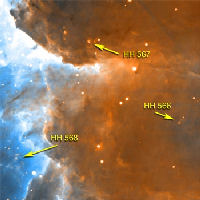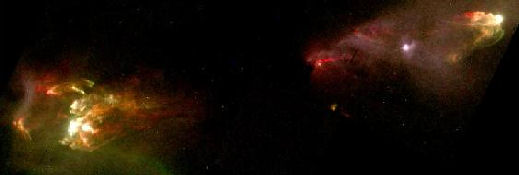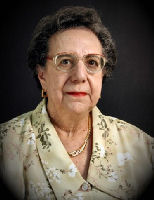A New Name
It was the Soviet astronomer,
Viktor Ambartsumian who named the objects Herbig-Haro. His research developed around the young stars and star foming regions with populations only a few hundred thousand years old. His study in this field led him to suggest that these areas, with their associated nebulosity, might represent an early stage in the formation of T Tauri stars. His research into the ideas of
protostellar evolution and
stellar cosmology were new and ground breaking theoretical developments, supporting the concept that star birth was a continual process, the regions of stellar birth containing new young stars in groups. See also:
The Mechanical Universe from
Ideas of Comology, the Center for History of Physics, Division of the American Institute of Physics.
What is a Herbig-Haro (HH) object and how do we know? Herbig-Haro objects "are small-scale shock regions intimately associated with star forming regions. They have characteristic spectra which set them apart from photo-ionized regions. The best way to unequivocally identify a nebulous object in a star forming region as an HH object is to take a spectrum." This description and our knowledge of the processes within star forming regions is a more recent (c.1980) understanding of the science behind these unique stellar objects. Let us step back for a moment and look at the two individuals who contributed both the research and their names to these stellar objects. [3]
H for Herbig

George Howard Herbig was born on January 20, 1920 in Wheeling, West Virginia. He's an American astronomer who specializes in spectroscopic research into irregular variable stars, notably those of the T-Tauri group. Having studied the spectra of these and other variable stars, he found that many of them contained a prevalence of lithium lines, similar to the abundance of lithium on Earth and in meteorites. He also found the same in the Sun, but of lesser amounts which led him to the conclusion that the abundance of lithium, in both the planetary and T-Tauri, might represent the original level of this element in the Milky Way. Image: Used with the kind permission of
George H. Herbig from his personal homepage.
In the 1940's George Herbig's survey work had primarily centered on the stars within the area around Burnham's Nebula, the very small star-like patch of nebulosity he saw close to the T Tauri star which was set aside as he continued to concentrate on the group of stars he was surveying. However, he was informed of Guillermo Haro's similar findings and after the two meet and discussed the objects at an astronomy conference in Tucson, Arizona, Herbig conducted further research into the object, noting that these small patches "displayed an unusual electromagnetic spectrum, with prominent emission lines of hydrogen, sulfur and oxygen." Further discovery of "newborn" stars in the region of the Orion nebula and subsequent studies showed areas of nebulosity due to bipolar outflow during the protostellar stage of star formation; this was the same type of stellar object for which Haro's independant research surveys had also found and descirbed.

Herbig has also studied binary stars systems — stars whose proximity and mutual gravitational attraction cause them to orbit one another ( see
Star Types, Binaries, this site ). He investigated the binary system of the shortest known orbital period, VV Puppis, which has an eclipsing binary with a 100 minute period. Image: VV Puppis from
Aladin previewer This star is classified as a Cataclysmic variable of AM Her type. It is located at RA 08 15 06.73 Dec -19 03 16.8 with a radial velocity of 81.0 km/s, a redshift
z = 0.000270 and a listed spectral type of M7V [4]
Currently astronomer emeritus at the University of Hawaii's Institute for Astronomy, Geroge Herbig's work continues to remain at the forefront of stellar research and education in spectral analysis within stellar populations and variable stars, parallaxes and proper motions for prototypes and the dynamics and properties of stellar evolution. His accolades and honors include:
- Ph.D., University of California, Berkeley, 1948
- Member, American Academy of Arts and Sciences
- Member, National Academy of Sciences
- Member Correspondant, Societé Royale des Sciences de Liége
- Warner Prize, American Astronomical Society, 1955
- Foreign Scientific Member, Max-Planck-Institut für Astronomie, Heidelberg
- Henry Norris Russell Lecturer, American Astronomical Society, 1975
- Medaille, Université de Liége, 1969
- Catherine Wolfe Bruce Gold Medal, Astronomical Society of the Pacific, 1980
- Petrie Prize and Lectureship, Canadian Astronomical Society, 1995
H for Haro

During this same period, a contemporary of Herbig's was busy with his own research work. His name was Guillermo Haro and he had reported the curious stellar clouds of nebulosity around some of the new star forming regions he was then surveying. A graduate of the
National Autonomous University of Mexico, Haro majored in philosophy but had also become actively interested in astronomy to such an extent that in 1943 he was hired as an assistant at the newly founded
Observatorio Astrofísico de Tonantzintla. Displaying both his enthusiasm and hard work for the science, Haro came to the United States in order to further his astronomical work and education, working at Harvard College Observatory from 1943 to 1944.

Returning to Mexico in 1945, Haro continued his work at the
Observatorio Astrofísico de Tonantzintla where he was responsible for the commissioning of the new 24-31-inch. Schmidt camera which would lead Haro into a collaboration with William Wilson Morgan as well as "...Luis Münch, Graciela and Guillermina Gonzalez, and other Mexican astronomers on the Tonanzintla Observatory staff in finding candidate OB stars for this program, on the objective-prism spectral plates they had taken with their respective Schmidt telescopes." Previously, Morgan "had taken part in the dedication of Tonanzintla Observatory in 1942 and had presented a paper on spectral classification that greatly influenced the early direction of the research program there." [5] Seen at right is a compilation of six images taken by the Hubble Space Telescope over five years, together creating a small moving image which reveals the motion of material in Herbig-Haro object HH47. Clicking on the image will take you to the Wikipedia website to view a large version of this image animation. Credit:
NASA
In addition to the Herbig-Haro objects, Guillermo Haro's work and research accolades include:
- The Project that Established the Observatory at San Pedro Mártir, Baja California in 1968 which now bears his name
- Haro-Chavira Comet
- Work on Flare Stars
- Blue Galaxies — Line Emission Study
- Supernovae and Peculiar Objects
- A Proposal on the Formation and Evolution of Stars
Guillermo Haro is one of the 1st generation of astronomers from Mexico's "dawn of Astrophysics" and one of the most famous behind
Luis Enrique Erro, considered one of Mexico's most distinguished scientists from the 20th century. He worked and collaborated with some of Mexico's leading researchers and astronomers, scientists and technicians that included: [6]
- The late physicist Carlos Graeff Fernandez who was a member of a very small community of cosmic ray researchers. He worked under Prof. Manuel Sandoval Vallarta, founder of modern physics in Mexico, in calculating the movement of particles in the magnetic field of the Earth. [7]
- Paris Pismis, the first woman to graduate from the scientific faculty of Istanbul University. She worked in Mexico from 1940 until her death there in 1999. She was a researcher in the area of galaxies kinematics, H II nebulae, the structure of open star clusters and planetary nebulae. She compiled the catalogue Pismis of 22 open clusters and 2 globular clusters in the southern hemisphere. ( Link to Astrobiografias in Spanish )
- Luis Rivera Terrazas, this is the "in honor of" website page. La trayectoria académica de Luis Rivera Terrazas by Dr. Gerardo Martínez, Montes Instituto de Física Luis Rivera Terrazas in Spanish. Terrazas worked, from 1943-1974, as a researcher with Guillermo Haro at the National Astronomical observatory of Tonantzintla
- Guillermina González was among the original Tonantzintla staff and, through her recommendation, her sister Graciela González joined the observatory a couple of years later. She was assigned to the archive of astronomical plates, and in the following years she was an active and valuable assistant to Guillermo Haro in the search for flares and transients in the Tonantzintla plates. She discovered a large number of flare stars and co-authored several papers with Haro [8]
fn.1
It is much to the credit of these and other early researchers whom worked hard to bring Mexico's institutions of science into the main stream of modern world astronomy.
Herbig-Haro Online

Seen at right is Herbig Haro 32 from the
Hubble Hertiage Site's NewsCenter, article entitled
Jets of Material Ejected From a Young Star "HH 32 is an excellent example of a "Herbig-Haro object," which is formed when young stars eject jets of material back into interstellar space. This object, about 1,000 light-years from Earth, is somewhat older than Hubble's variable nebula, and the wind from the bright central star has already cleared much of the dust out of the central region, thus exposing the star to direct view."
Credit: NASA and The Hubble Heritage Team (AURA/STScI).
Historical Development of
Mexico's Astronomical Science

Image of the Pelican Nebula, Herbig-Haro (HH) Object 555 from the
National Optical Astronomy Observatory Monday, October 6, 2003, Release number NOAO 03-08. "Intense radiation from several massive stars located just off the image is eroding the surrounding molecular cloud. In regions shadowed by dense clumps of gas and dust, parts of the cold molecular cloud survive to produce the long "pillars" of dusty material. A faint jet (known as Herbig-Haro object 555) squirts out of the tip of one of the pillars, indicating the presence of an unseen protostar."
Clicking on the link above will take to the NOAO website where you can view "a magnified view of a region of the Pelican Nebula that contains several groups of Herbig-Haro (HH) Objects. Click a highlighted area in the image to view a magnified version of that part of the image with the HH Objects in that region labeled"
Credit: University of Colorado, University of Hawaii and NOAO/AURA/NSF.
- SCIENCE NEWS Science Service, Washington, D. C. MEXICAN ASTRONOMICAL EXPEDITION TO OBSERVE THE TOTAL SOLAR ECLIPSE vol.99, No.2558, p.10. January 7, 1944 .pdf format, an interesting tidbit
- World Beat: Mexico by Marco Arturo Moreno-Corral, Universidad Nacional Autónoma de México and Mars A. Rodríguez, Marsian International Copyright ©2001-2009 Astronomical Society of the Pacific
-
Astronomers in Mexico, by Vladimir Escalante-Ramírez Ramírez, Vladimir, "Astronomers in Mexico," ReVista, the Harvard Review of Latin America. Volume VIII, Number 3. pp. 48. Spring 2009.
- THE AWAKENING OF MODERN ASTROPHYSICS IN MEXICO AND THE HARVARD COLLEGE OBSERVATORY. MEXICAN-AMERICAN INTERNATIONAL AFFAIRS DURING SECOND WORLD WAR © Jorge Bartolucci, from the Astronomy Workshop at the University of Norte Dame
Sources

Image of Herbig-Haro 1 and 2 from the
APOD website "A cloud of interstellar gas and dust collapses and a star is born. At its core temperatures rise, a nuclear furnace ignites, and a rotating dusty disk forms surrounding the newborn star... [t]he bright blobs at either end are where the jet material has slammed into interstellar gas. Tip to tip, the distance is about one light-year."
Credit: J. Hester (ASU), WFPC2 Team, NASA
- "Burnham, Sherburne Wesley" 22 April 2009. HowStuffWorks.com 06 June 2009.
- "Sherburne Wesley Burnham" 30 April 2009. Wikipedia 06 June 2009.
- "Herbig—Haro object" Wikipedia 06 June 2009. Also see The Bruce Medalists - George Howard Herbig by Joseph S. Tenn 2008-01-25 and George Herbig from NNDB Tracker website, Copyright © 2009 Soylent Communications
- vv Puppis from Simbad, C.D.S.-SIMBAD4 rel 1.123-2009.06.11CEST23:43:08
- Osterbrock, Donald E. William Wilson Morgan
January 3, 1906—June 21, 1994
- Information from the "The Relevant Science Blog" a website for "Comments and links to reports on science, and its applications", June 09, 2009
- The National Institute of Optical and Electronic Astrophysics 60 Years of Scientific research
- GRACIELA GONZALEZ 1928—2006 Biography from Revista Mexicana de Astronoma y Astrofsica, 43, 233—233 (2007) © Instituto de Astronomía, Universidad Nacional Autónoma de México

 Sherburne Wesley Burnham was born in 1838 in Thetford, Vermont. During the Civil War he found himself employed as a military stenographer in the Union Army and later, while serving with the Union occupation forces in New Orleans, he bought an astronomy book at an auction. It so aroused his interest that in 1869 he bought a six-inch (152-mm) Clark refractor telescope. Image: Unknown source and copyright. Pending search for permission or copyright information, orignially believed to be in the public domain or subject to the "Fair Use" provisions of US Copyright Law. [1]
Sherburne Wesley Burnham was born in 1838 in Thetford, Vermont. During the Civil War he found himself employed as a military stenographer in the Union Army and later, while serving with the Union occupation forces in New Orleans, he bought an astronomy book at an auction. It so aroused his interest that in 1869 he bought a six-inch (152-mm) Clark refractor telescope. Image: Unknown source and copyright. Pending search for permission or copyright information, orignially believed to be in the public domain or subject to the "Fair Use" provisions of US Copyright Law. [1] It was with his small telescope that he began his astronomy career as an amateur observer. He discovered 400 double stars and as a result of the fame thus achieved, was awarded an appointment to Lick Observatory (1888-92) and Yerkes Observatory (1897-1914), where he made hundreds of additional discoveries. As a result of his work he published a General Catalogue of Double Stars within 121° of the North Pole (1906) which contained data on 13,665 double stars, more than a thousand of which he discovered. His work on this catalog spanned 36 years, having begun in 1870 and not seeing release until 1906 when it was published by the Carnegie Institution of Washington. His catalog in now online and may be view at the
It was with his small telescope that he began his astronomy career as an amateur observer. He discovered 400 double stars and as a result of the fame thus achieved, was awarded an appointment to Lick Observatory (1888-92) and Yerkes Observatory (1897-1914), where he made hundreds of additional discoveries. As a result of his work he published a General Catalogue of Double Stars within 121° of the North Pole (1906) which contained data on 13,665 double stars, more than a thousand of which he discovered. His work on this catalog spanned 36 years, having begun in 1870 and not seeing release until 1906 when it was published by the Carnegie Institution of Washington. His catalog in now online and may be view at the  George Howard Herbig was born on January 20, 1920 in Wheeling, West Virginia. He's an American astronomer who specializes in spectroscopic research into irregular variable stars, notably those of the T-Tauri group. Having studied the spectra of these and other variable stars, he found that many of them contained a prevalence of lithium lines, similar to the abundance of lithium on Earth and in meteorites. He also found the same in the Sun, but of lesser amounts which led him to the conclusion that the abundance of lithium, in both the planetary and T-Tauri, might represent the original level of this element in the Milky Way. Image: Used with the kind permission of
George Howard Herbig was born on January 20, 1920 in Wheeling, West Virginia. He's an American astronomer who specializes in spectroscopic research into irregular variable stars, notably those of the T-Tauri group. Having studied the spectra of these and other variable stars, he found that many of them contained a prevalence of lithium lines, similar to the abundance of lithium on Earth and in meteorites. He also found the same in the Sun, but of lesser amounts which led him to the conclusion that the abundance of lithium, in both the planetary and T-Tauri, might represent the original level of this element in the Milky Way. Image: Used with the kind permission of  Herbig has also studied binary stars systems — stars whose proximity and mutual gravitational attraction cause them to orbit one another ( see
Herbig has also studied binary stars systems — stars whose proximity and mutual gravitational attraction cause them to orbit one another ( see  During this same period, a contemporary of Herbig's was busy with his own research work. His name was Guillermo Haro and he had reported the curious stellar clouds of nebulosity around some of the new star forming regions he was then surveying. A graduate of the
During this same period, a contemporary of Herbig's was busy with his own research work. His name was Guillermo Haro and he had reported the curious stellar clouds of nebulosity around some of the new star forming regions he was then surveying. A graduate of the

 Seen at right is Herbig Haro 32 from the
Seen at right is Herbig Haro 32 from the  Image of the Pelican Nebula, Herbig-Haro (HH) Object 555 from the
Image of the Pelican Nebula, Herbig-Haro (HH) Object 555 from the  Image of Herbig-Haro 1 and 2 from the
Image of Herbig-Haro 1 and 2 from the